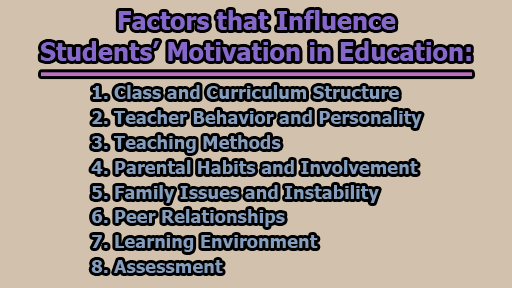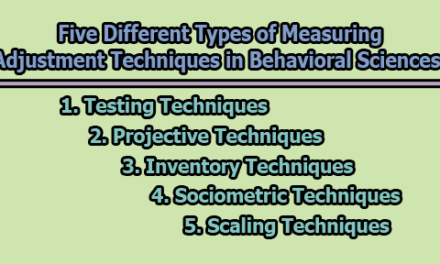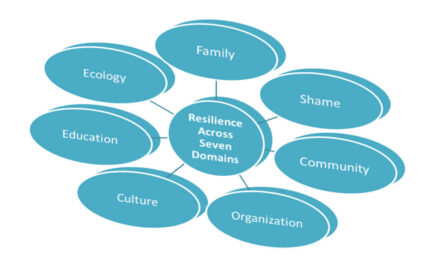Factors that Influence Students’ Motivation in Education:
Motivation is the driving force behind a student’s engagement, learning, and overall success in the educational sphere. As educators, parents, and policymakers strive to enhance the learning experience, it becomes imperative to delve into the intricate web of factors that influence students’ motivation. From the structure of classes and curriculum to the dynamics of teacher-student relationships, familial influences, peer interactions, the learning environment, and assessment methods, each component plays a pivotal role in shaping a student’s educational journey. In the rest of this article, we explore some of the essential factors that influence students’ motivation in education.
1. Class and Curriculum Structure: The foundation of a positive educational experience lies in the structure of classes and curriculum. Students thrive in environments where there is a sense of order and predictability. When classes adhere to a well-thought-out structure, and educators have meticulously prepared materials in advance, students experience a heightened sense of security. This security, stemming from the fulfillment of a basic need, allows students to channel their focus entirely on the learning material.
To create an environment that fosters security, educators must plan classes meticulously. Preparing materials in advance and clearly stating the objectives of a course or class at the outset of a semester contribute significantly to students’ sense of stability and focus.
2. Teacher Behavior and Personality: Teachers serve as crucial influencers in a student’s life, shaping not only their understanding of the subject matter but also their overall attitude towards education. A negative emotion, such as fear or dislike, towards a teacher can have far-reaching consequences on a student’s motivation. It is paramount for educators to be mindful of their behavior and the language they use in the classroom.
Teacher behavior characterized by kindness, optimism, positive feedback, and encouragement has a profound positive impact on students’ motivation to learn. Conversely, preferential treatment towards certain students or the use of derogatory and humiliating language can create a negative atmosphere that hampers motivation.
3. Teaching Methods: The diversity of teaching methods is a key factor in sustaining students’ motivation. A monotonous teaching approach can lead to boredom, diminishing the enthusiasm for learning. Recognizing that students within a single class may have different learning styles, educators should employ a variety of teaching methods to cater to these diverse needs.
Allowing students choices, such as deciding on partners for collaborative work, promotes a sense of autonomy. Practical applications of knowledge, especially in subjects like science, technology, engineering, and mathematics (STEM), can significantly enhance motivation. In cases where students’ needs are not fully met within the traditional classroom setting, enrolling in extracurricular activities or seeking support from tutors can address individual learning requirements.
4. Parental Habits and Involvement: The influence of parents extends beyond the confines of the classroom. Several parental habits indirectly affect a child’s intrinsic motivation. Parents who show genuine interest in their child’s learning material, inquire about their day, actively listen, assist with specific tasks or skills taught at school, attend parent meetings, and encourage completion of homework contribute positively to their child’s motivation.
Reading, particularly when done with and to young children, accelerates literacy development and sets the stage for future academic success. Parental involvement is a powerful catalyst for a child’s motivation and overall success in education.
5. Family Issues and Instability: The home environment plays a crucial role in shaping a student’s motivation. Lack of security at home can have a detrimental impact on a student’s educational journey. Research suggests that children who live with both parents, on average, achieve better academic grades than those who do not.
Family issues such as divorce, loss of one or both parents, not living with the biological father or mother, lack of contact with biological parents, frequent relocations, and involvement with Child Protective Services can result in poorer academic performance. In such instances, schools may need to provide additional support to help students cope with the challenges arising from family-related issues.
6. Peer Relationships: As students progress through their academic journey, the influence of peer relationships becomes increasingly significant. Conflicts, bullying, and other peer-related issues can have a profound impact on students’ feelings of security, stress levels, and overall motivation in education.
Educational institutions should be vigilant in identifying and addressing peer-related challenges. Creating a supportive and inclusive environment that fosters positive peer relationships can contribute to a healthier and more motivated student body.
7. Learning Environment: The broader school environment, often referred to as the school climate, is a critical factor influencing motivation in education. This encompasses the norms, regulations, and overall atmosphere within the school. A positive school environment ensures that students feel safe and secure, their basic needs are met, and they can form healthy social relationships.
However, striking the right balance is essential. Too many classes and an overly serious learning environment can have adverse effects on motivation. Introducing elements of fun into classes, allowing sufficient time for play and rest, and ensuring a holistic approach to student well-being can significantly enhance motivation and academic performance.
8. Assessment: Assessment methods play a crucial role in determining students’ motivation levels. While standardized assessments aim to raise the standards of attainment, their impact on student motivation, especially at a younger age, is a topic of concern. In countries like Finland, where primary school children do not undergo standardized tests, students display higher academic achievements.
Continuous exposure to overly challenging tests without a sense of achievement can lead to a decline in motivation over time. Educators should experiment with and apply different testing methods that address the diverse learning needs of students, striking a balance between challenging assessments and fostering a sense of accomplishment.
In conclusion, understanding the myriad factors that influence students’ motivation is essential for creating a conducive and nurturing educational environment. From the foundational elements of class structure and teacher behavior to the intricate dynamics of family and peer relationships, each factor plays a unique role in shaping a student’s motivation in education. By recognizing and addressing these factors collaboratively, educators, parents, and policymakers can foster a learning environment where students are motivated, engaged, and empowered to achieve their full potential.

Library Lecturer at Nurul Amin Degree College










